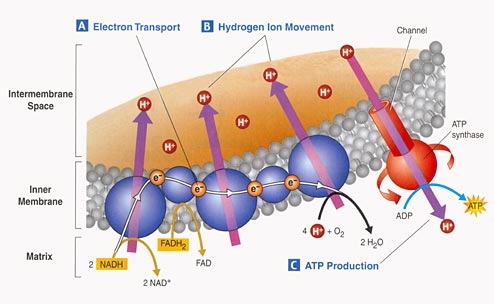The NADH harvested from the Krebs cycle is oxidised back to NAD. This produces a stream of free electrons because, remember, oxidation = loss of protons or electrons. These electrons progress through the electron transport chain from coenzyme to coenzyme, down an energy gradient. Eventually they must be accepted by a terminal electron acceptor. This is oxygen, and that is why O2 is needed in aerobic respiration. The product is water, H2O.

The abundant ATP molecules are produced when the electron transport chain creates a proton gradient across the mitochondrial inner membrane (cristae). Since the gradient drives the force of protons being transferred across to the side where there are less of them, ATP is produced when the protons go through special cross-membrane enzymes which use the energy derived from their passage to turn one ADP molecule into one ATP molecule. This is chemiosmosis.
